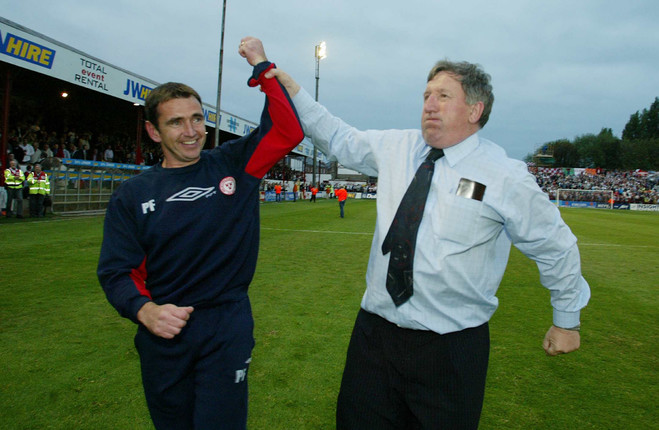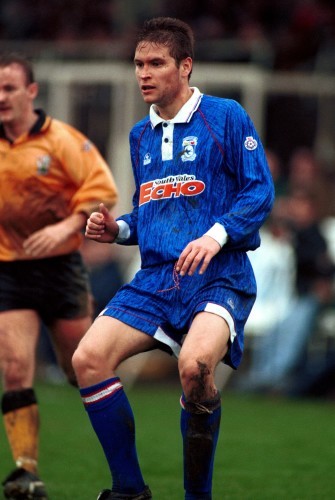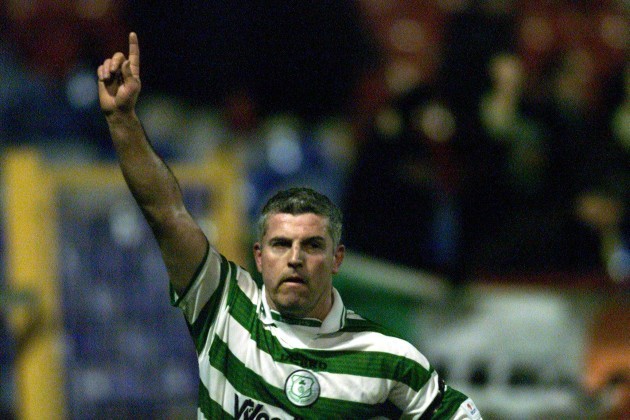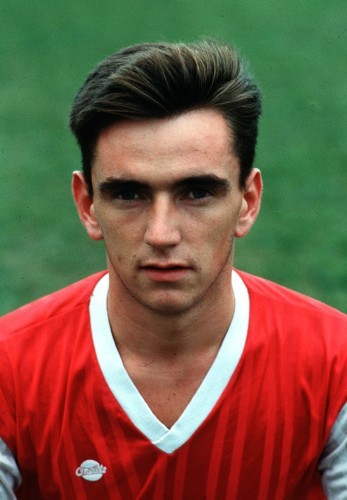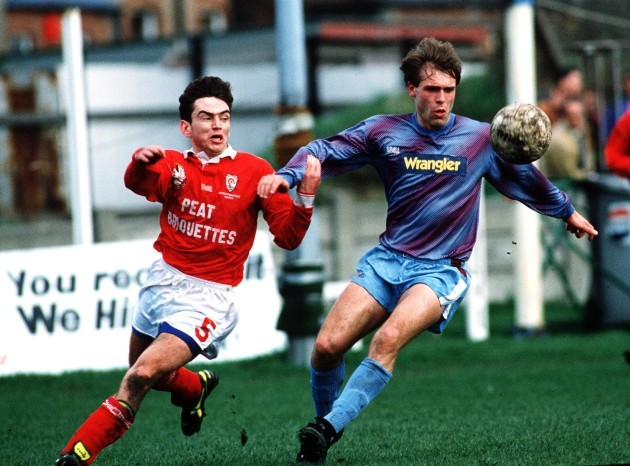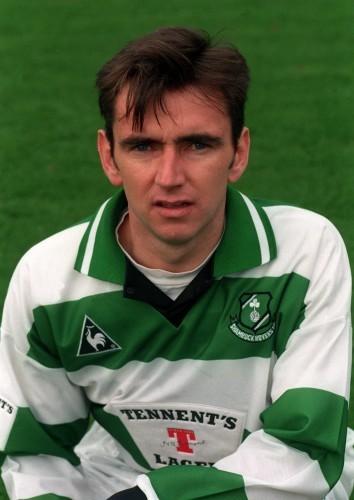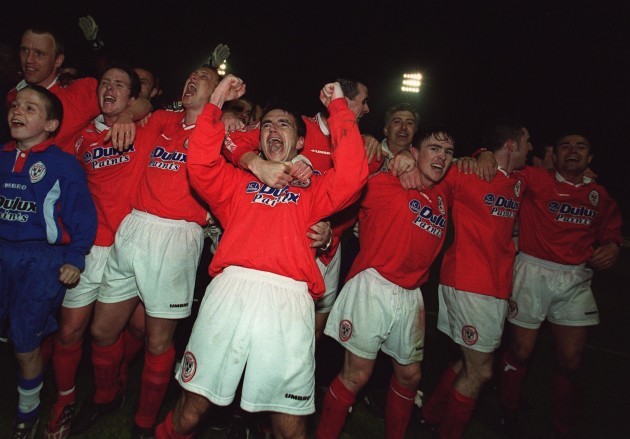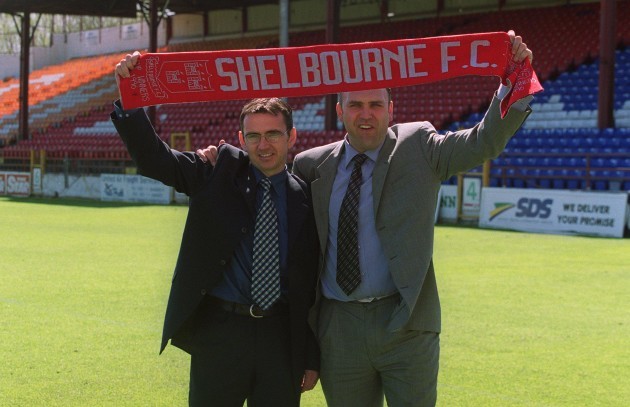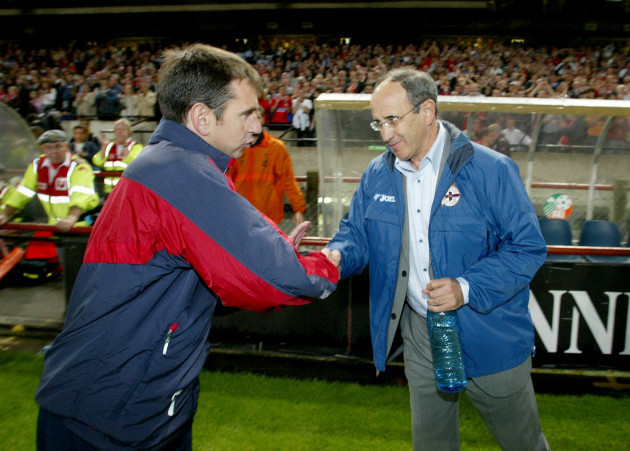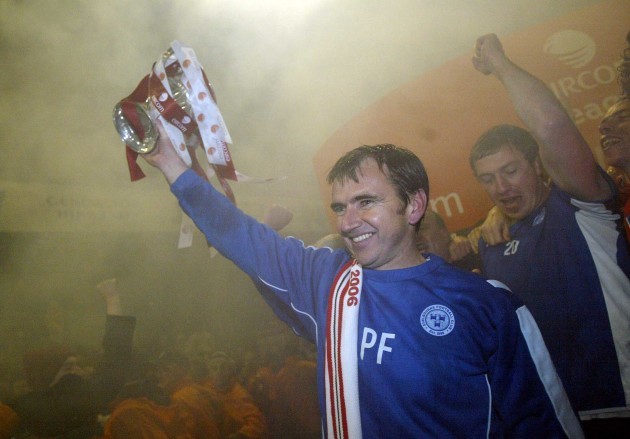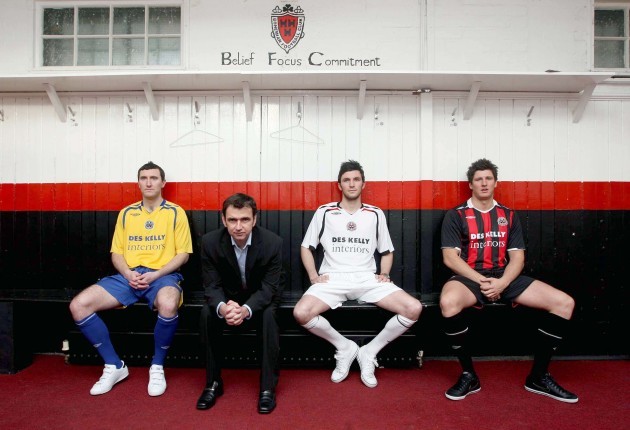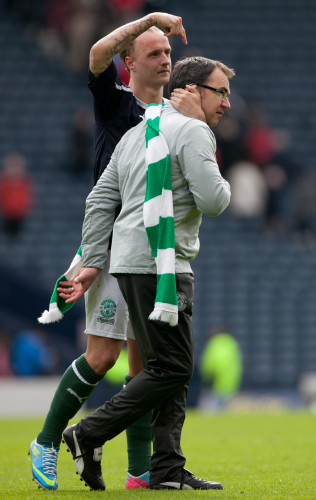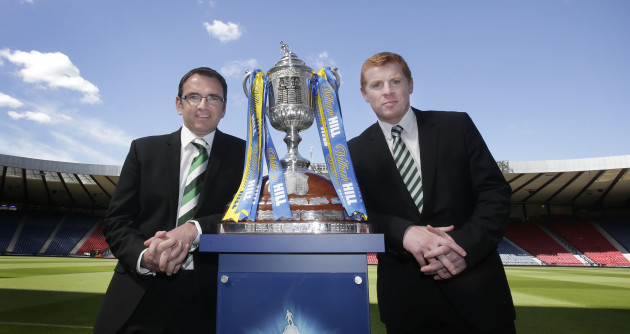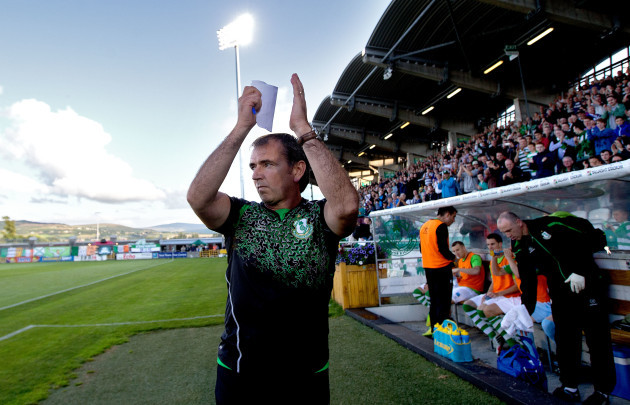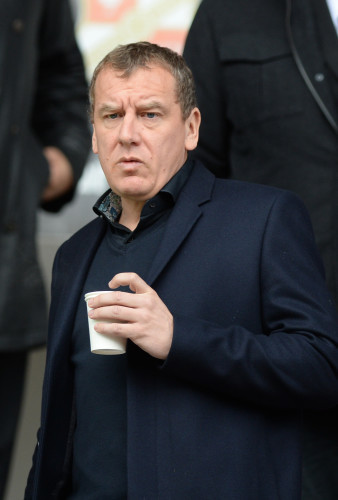EVEN IF PAT Fenlon never steps foot in a dug-out again, he will go down as one of the most successful Irish managers ever to grace the game.
At 48, the Dubliner has got five Premier Division titles to his name as well as the FAI Cup, Setanta Sports Cup, League of Ireland Cup and two Scottish Cup runners-up medals.
Then there were the European victories over Hajduk Split and KR Reykjavik in 2004, when he led Shelbourne to within a whisker of qualifying for the Champions League group stages after a famous 0-0 draw with Spanish heavyweights Deportivo La Coruna at Lansdowne Road.
Not that they should, but the long list of achievements might somehow make it easy to overlook his playing days. However, that would be doing the man nicknamed ‘Nutsy’ a great disservice as his career as a tenacious, goalscoring midfielder is arguably just as impressive.
Brought up in Finglas South, where he moved with his family from Ballymun at the age of four, Pat’s first experience in organised football was at Tolka Rovers. He signed after being introduced to the club by local postman Jimmy Byrne — brother of a future Chelsea and Bohemians team-mate Tommy.
“I was probably naturally talented but I worked hard,” Fenlon tells The42. “I had ability, there was no doubt about that, but it would have been drummed into me that to get anything out of that I would have to work hard. And that’s what I did.”
After a couple of years, Fenlon made the switch to Home Farm after appearing in their mini-leagues but, after the age of 14, they decided he wasn’t “big or strong enough”.
“I would have been disappointed,” he says. “I don’t know whether it spurred me on, because I always had belief that I was a decent player so I just moved on to where I was appreciated.
“You’re always going to get knock-backs in football, whatever level you’re playing at. You just have to deal with it. It probably helped me to be rejected when I was a little bit younger as I had to prove myself again.”
So the decision was made that he would join Lourdes Celtic — on the other side of the city in Crumlin. Fenlon attended Patrician College at that time and although he is the first to admit that he “wasn’t very good academically”, school had its benefits.
“Patrician College was well-renowned for its football in those days,” he explains. “I played in the same school teams as Ricky McEvoy, Martin Russell and Derek Brazil, who were all good players.
“We had a very, very successful school team around then, and we won All-Irelands and Leinster titles by the bucket-load.”
Fenlon loved his time at Lourdes but the travelling took its toll so he left for Rivermount Boys after one season.
It was two bus journeys over — one into town and one out — then two back,” he remembers. “Those were the days when you’d let your children do that!
“I enjoyed the year I had a Lourdes but it was just the distance involved. My local club Rivermount had just got promoted to the Premier Division and I went there.”
And that’s where Fenlon’s career began to take off. He earned Ireland caps at U17 level and scored a couple of goals against Northern Ireland in the Mardyke in Cork. Chelsea scouts were watching that day and, with other clubs including Nottingham Forest also interested, he was invited over to London.
“Me and Tony Cousins were there together and we played in a trial match against Tottenham,” Fenlon says. “They beat us 10-1, but I scored the one and I must have done alright because they offered me a contract after the game.
“I was supposed to be there for 10 days but they told me to ring my dad, go home and bring him back over. We returned and I signed a three-year deal there and then, which was brilliant.”
Cousins joined too and the paired roomed together in London, which Fenlon describes as being “a little different to Dublin”. As a 17-year-old, the experience allowed him to mature and he credits the commute back and forth from their digs in North London to Chelsea’s training ground with helping him to grow up.
“I always said it was the best thing I ever did,” he says. “Not from the football side of it, but from a life point of view. We lived with a lovely couple from Killorglin in County Kerry and they were brilliant to me. It was a great learning curve.”
On the pitch, however, the midfielder wasn’t progressing as well as he would have hoped.
“I thought I developed well in the first year and stagnated a little bit after that,” he explains. “I had about a year-and-a-half on my contract after that and it just wasn’t working out. They obviously didn’t fancy me and I wasn’t good enough at the time.
“I decided I’d rather come home than sit there and waste my time. So I returned to try my hand in Ireland about 18 months into the contract.”
Back in Dublin, Fenlon went to train with the club he supported all his life, Shamrock Rovers, but no offer came. Brian Kerr knew the player well from the Ireland U17s and he was invited up to St Patrick’s Athletic.
Initially playing in the reserves, breaking into the first team took awhile but Fenlon and John Ryan — scorer of a hat-trick for Bray Wanderers in the 1990 FAI Cup final — were catching the eye.
“They were still at the old Richmond Park and we trained behind the shed,” he recalls. “We used to call it the pig pen, it was a muck bath where I think the sheep went before they met their doom.
“We also trained over in St Michael’s estate and up in Walkinstown Park. It probably gelled us together and we had a lot of good lads there. I still have plenty of good friends from my Pat’s days.”
It was only a matter of time before he made the step up to become a regular fixture in the team and in the 1989/90 season the Saints claimed a first league title in 34 years.
I loved it and it was a very good club at the time — it still is,” Fenlon says. “Brian assembled this team out of nothing and we won a league title. He’s probably the best manager I’ve played under and it was a great period.
“We had a lot of fellas who had been rejected by others clubs and I fitted into the category. We didn’t have anything in terms of resources but it was really enjoyable.
“I grew up as a League of Ireland fan following Rovers and I knew what it was all about. As Pat’s hadn’t won it in so long, it meant a lot more to the supporters of the club and the people running it.
“To win it in the circumstances that we did, with a team that was coached into a very good side, was great. There were brilliant people at the club and I really enjoyed my football.”
Fenlon had more than his fair share of injuries over the years and suffered a couple of set-backs while at Pat’s — breaking the same leg twice. The first was on Ireland U21 duty playing against Senegal in Toulon. In his first match back after recovering from that, he sustained a near-identical fracture.
But he recovered fully and, by 1991, it was time to move on.
“When you become successful, the clubs that are bigger financially take notice,” he says. “Eamonn Gregg had been a player at Pat’s and I got on really well with him. Curtis Fleming and myself went into Pat’s together and Eamonn took Curtis under his wing even though he was going to replace him eventually.
“Eamonn got the job at Bohs with Morry Price, who I worked with at Pat’s. They came in and asked me did I want to sign for Bohs. They offered me more money, there’s no point saying anything else, and I thought it was a club on the up as they had brought in some good players.”
Bohs lifted the 1992 FAI Cup — beating Cork City 1-0 in the final — in a year that Fenlon was recognised as PFAI Player of the Year. His excellent form opened up the possibility of having another crack in English football around that time, but he turned down the advances.
“I’d think during those few years at Bohs I played my best football. There were a few options to go back to England but there was nothing that really interested me. They weren’t going to be life-changing for me and I was enjoying my football.”
Flying a club level, Fenlon received a call-up to the Ireland B squad for a match against Denmark that February.
“At that stage, Ireland had some tremendous players in midfield and to get a B international cap and play for my country, from a football point of view, is the highlight of my career,” he says.
The game was played at Tolka Park and Fenlon got his name on the scoresheet along with David Kelly in a 2-0 victory. Coincidentally, he was substituted off and replaced by Lee Power — the man he currently works for at Waterford.
“I was very happy with my performance that night and I came away thinking ‘you’ve done well enough, if something comes out of it then great’.
You’re playing for your country and it doesn’t get any better for me than that. I did as well as I could have done but at the time we had some incredible players in midfield for Ireland. Even being that close, I was probably a long way off.
“You always want to play for your country. I was fortunate enough to play U21 and a B international so I’m pleased enough with that.”
He was later included in Jack Charlton’s senior squad to play Manchester United at the old Lansdowne Road but that was as close as he came to a full senior cap.
By 1994, his spell at Bohemians had run its course and an opportunity to play north of the border arose — with Linfield and Ards both keen.
“I spoke to the two clubs but once Linfield were interested there was never a chance of me going to Ards. There were a few clubs in the south that wanted me too but I felt it was time for a change — although some people might have said Linfield in those days wasn’t the change I needed.”
Given Linfield’s history as a staunchly-Protestant club and the fact that Fenlon was the first Catholic from Dublin to sign for them, it’s understandable that he had some initial doubts about the move.
“I’m not going to lie, there were obviously reservations as I had to weigh up being a Catholic going to play for Linfield.
It was just at the end of the troubles, but once I got to meet the people and speak to them there was no issue with it.
“They were also willing to pay £25,000 for me, which was a fair bit of money in those days. There would have been apprehension at the start but I only have good things to say about it as a football club.”
Fenlon remained living in Dublin and travelled up and down with a couple of team-mates, who would drive to the Fairways Hotel just outside Dundalk where they were picked up by Gary Eccles.
On match-day, it was a train ride up. However, they got off at Newry and took a lift from there due to the threat of bomb scares on the line to Belfast.
As Fenlon explains, he didn’t get off to the best of starts at the club but soon won them over.
“I was struggling for the first four or five games with an ankle injury. They were expecting big things because they had paid a lot of money for me and I didn’t play well so I was getting booed when I got taken off.
“Then I hit a bit of form and scored a goal against Cliftonville at Windsor Park and the fans had a go at the manager when he substituted me.”
He insists that he was treated well by both sets of fans in general and adds that chants about religion were uncommon.
“I have to be honest in relation to playing in the north, I very rarely received any sectarian abuse up there. The only stick I got for playing for Linfield was down south, unfortunately, but that’s just part of life and you have to turn the other cheek.”
On the last day of the 1993/94 season, Linfield were third in the table but a win over Glentoran, inspired by a goal from Fenlon, coupled with Glenavon’s draw with Portadown handed them the title.
The also went on to lift back-to-back Irish Cups and Fenlon can’t speak highly enough of the Blues.
“It’s the best football club I’ve ever played for,” he states. “I had a brilliant time there. I’ve said it before, teams down south could take a leaf out of its book. It’s run like a proper football club with a huge fanbase, there’s great honesty with the people and they look after their players properly.
“It was one of the happier times I had and we had huge success there, which helps. I played with a lot of good players too.”
Returning to Dublin in ’96, Fenlon was offered the chance to live a boyhood dream and sign for Shamrock Rovers. However, at this stage, he had already agreed to join their city rivals Bohemians.
“Rovers was my team and it was the team I wanted to play for,” he says. “When I came back, I said I’d move to Bohs but I changed my mind when Rovers came in. I got a bit of stick over it and probably rightly so.”
Terry O’Neill and Terry Eviston had just taken charge but the team didn’t perform and they were replaced by Pat Byrne. Fenlon’s stay was short-lived and he left after just one season.
“In fairness, we hadn’t got a bad squad and we definitely underachieved,” he says. “We struggled and the two boys lost their jobs. I get on with Pat now but I won’t say we got on great when I was there.
“I was away on holiday and came back to find out they had agreed a fee with Newry for me. I wasn’t happy with that and I ended up signing for Shelbourne. Overall, the Rovers move didn’t work out the way I would have wanted it to.”
Shelbourne had just won consecutive FAI Cups under Damien Richardson and owner Ollie Byrne was building an outstanding side. He didn’t know it at the time, but Fenlon was about to begin an unprecedentedly-successful 10-year association with the club.
“It was a great move,” he says. “Damien was away at the time so I met Ollie and Finbarr Flood and was sold on it straight away. I was there for 10 years as a player and a manager and they were fantastic times. I’ve been fortunate to play for a lot of the big clubs in the country.
Shelbourne was great and Ollie was just Ollie. He was different — a one-off.”
A triple-fracture to his shin was to put Fenlon out of action for a considerable time when a friend, Paul Whelan of Shamrock Rovers, left him with the bone protruding through the skin.
“Things happen in football and I got over it by working really hard with Larry Byrne, who was the physio at the time,” he says, thinking back. “I spent a lot of time in Dollymount and Portmarnock, running in the sand dunes and getting into the sea to take the swelling down.”
And the countless hours of rehabilitation were well worth it in the end as Fenlon returned to win a league and cup double in 1999/2000 – scoring the winning goal in the FAI Cup final replay against Bohemians. He topped it off by earning the league’s Player of the Year for a second time.
“I just had one of those seasons that you dream of,” he explains. “I scored a goal in the cup final to win the double and I enjoyed a good campaign in the league. We had a very strong team with some excellent footballers.”
Dermot Keely, who had replaced Richardson, departed in 2002 and Byrne took a gamble by offering Fenlon — with no managerial experience — a player-manager role.
He noticed himself slowing down a bit due to the injury and managing had been in the back of his mind since starting his badges at a Fas course, but taking the job at 32 years of age felt a little premature.
“I wanted to get into managing but I didn’t have it in mind to do it as quick I did. It was just a conversation when Dermot left. It was put if I was interested in taking charge and seeing how it went.
“It could have went badly wrong and that probably would have been the end of me and coaching. But Ollie had a belief in me that I could do it.
“It was a difficult one because I had played with all the players in previous seasons so you’re probably going to fall out with people who would have been classed as good friends. But that didn’t bother me because I had that streak to me that it was about winning.”
Shels lost out to Malta Hibernians in the first qualifying round for the Champions League and Cork City knocked them out of the FAI Cup early on, but they turned the season around and finished runners-up to Bohemians in the Premier Division.
Byrne asked him to stay on and Fenlon decided he’d pack in the playing to give his complete attention to the running of the team.
“I’m a little bit sad that the playing career ended earlier than it should have. I would have liked to play on but whether my body would have let me I don’t know. I was still young and the lads are playing a lot longer now.
It was circumstances more than anything else and from the point of view of my body it was probably the right time.
“When I went in as a player-manager, I played two or three games. I got sent off against Pat’s in a cup match in Inchicore and I never played again. It was just too much. I was trying to play and manage and it wasn’t fair on the players so I just cut my losses and concentrated on the managing.”
In the four years that followed, Shels were crowned champions all but once. The run in the 2004/05 Champions League qualifiers is still spoken about today as a team featuring the likes of Jason Byrne, Wes Hoolahan, Dave Rogers, Stuey Byrne and Owen Heary held Deportivo — semi-finalists the previous year — to a 0-0 draw in front of 25,000 at Lansdowne before eventually losing out 3-0 at the Estadio Riazor.
For Fenlon, the 2-0 win over Hajduk Split — after they had lost the first leg 3-2 — stands out above the rest.
“The night in Tolka Park won’t ever be beaten for the pure bedlam, pandemonium and celebration,” he says. “We had a game plan we had two away goals and we felt we could keep it tight and nick a goal, which would make it difficult for them.
“Rodgy’s fantastic strike will be remembered forever, then we put Joseph Ndo on to take the ball into the corners. Fortunately, he did that then squared to Alan Moore to make it 2-0. It was just a special night.”
By 2006, Shelbourne had serious problems off-the-pitch as a financial crisis saw the players threaten to go on strike after the non-payment of wages.
Uncertainty dogged the club, but Fenlon, his staff and the squad put that to one side and pipped Derry City to the league on goal difference.
“That last league title was satisfactory because of the circumstances we won it in,” says Fenlon. “I had a great staff with me, they hadn’t been paid for 11 or 12 weeks. It was a difficult time for them, for some it was their only job.
“The players just decided that they were at the top of the league and had worked incredibly hard to get there so they didn’t want to let it go. In fairness to them, they put in some great performances and it was an unbelievable achievement.”
On the late Byrne, who passed away in 2007, he adds: “People outside the club probably didn’t realise what he was about and what he was like. His only wish and his only desire was to make Shelbourne better, and he wanted to do it by any means.
“Where he brought the club to with that run in Europe was some achievement. Most of the credit should go to him for that — not everybody else.
“He had the belief that it could happen. I don’t think anybody else in the country did. He believed that we could win against Deportivo when the draw came out.
He said ‘listen, we’ve got a chance of beating them’ even though they had been in the Champions League semi-finals the year before. That was the belief he had.”
Fenlon left Shels with the vast majority of the players and the club was demoted to the First Division. He took over at Derry City but lasted just five months in the position.
A trophy-laden stint at his former club Bohemians was next on the cards and in three years, Fenlon won two league championships, the FAI Cup, the Setanta Cup and the League of Ireland Cup.
Those achievements didn’t go unnoticed and Dundee United wanted to make him their manager in 2010. He left for Scotland a year later, but it was Hibernian who secured his services as a replacement for Colin Calderwood.
“I had an opportunity to go to Dundee United and that fell through,” Fenlon explains. “Then the offer came from Hibs and it’s something that you can’t turn down.
“It’s fantastic football club and there’s no comparison to any in the League of Ireland. They don’t come anywhere near it in terms of the size of the club, the fanbase, the training facilities and the stadium.
“I had a great time there. What I wanted to do was to get myself to a level of the elite professional side of the game.”
The Edinburgh club were in danger of relegation and, despite a slow start, the new manager guided them to SPL safety in 2012. Hibs also booked their place in the Scottish Cup final that season, but disappointing lost 5-1 to city rivals Hearts.
The following year saw Hibs briefly sit top of the table and they appeared in the Scottish Cup final for second time, but again lost — this time 3-0 to Celtic. In November 2013, Fenlon decided to walk away from the job but he has fond memories of that period.
“We got beaten badly in a cup final by Hearts and by Malmo in Europe, which was a disaster and people will remember them,” he accepts.
“But for me, the only two Scottish Cup games I lost were cup finals. We went to to Hamden Park four times — winning two semi-finals, which was brilliant. To lead the team out in the cup final against Celtic was special, that was probably the highlight of my career even though the game didn’t go very well.
“We had some great times — beating Celtic at Easter Road and winning at Tynecastle with late goals from Leigh Griffiths. I have great memories and it was a special club.”
Fenlon was on the market once again, and this time Rovers came calling. As he explains, there was only ever going to be one answer.
“It was an absolute no-brainer and a job I always wanted. When it came up and I got the offer it was something I couldn’t turn down. It’s a great football club.”
An emphasis was put on a long-term project and building for the future as the Hoops invested in underage structures. However, as the country’s most successful club, the expectation levels are constantly high among Rovers fans.
They finished third in the table under Fenlon in 2015 and were sitting fourth the following season when it was announced that the manager and club had parted ways.
“You don’t look back,” Fenlon reflects. “The proof is in the pudding and in the only full season I had we finished third and we got through a round in Europe. For me, that was success for Rovers. That’s what they spoke about — getting through a round in Europe and being competitive in the league.
Things went a little bit sour the following season. Certain people in the club had other ideas and I wasn’t willing to go down that road.”
Rovers are being praised for bringing through several young players under Fenlon’s successor, Stephen Bradley, this term. But he believes it is the fruits of his labour.
“We were trying to develop players and bring in a system that I wanted to see through as well. If you look at the team at the moment, people talk about all these young players but most of them came through and made their debuts when I was there. There are maybe one or two that didn’t.
“That can sometimes be a little bit annoying that you don’t get the credit, but look it, it’s not about looking back, it’s about looking forward.”
As a general rule, Fenlon’s outlook on life doesn’t involve having regrets.
“I think if you look back you’re only going to eat yourself up so it’s a case of learning whether something goes well for you or not.
“The way I look at my career, whether playing or managing, is that there are a lot of people who would have liked to do what I did so it’s been a privilege in my end of it.
“As a player or a manager, you’re only passing through. The club is the club, wherever you are. I definitely don’t have any regrets.”
Earlier this year, Fenlon was approached to take over a director of football at Waterford. Now run by his old Ireland team-mate Lee Power, the SSE Airtricity League First Division club have their sights on the top flight and wanted a man of his experience to assist manager Alan Reynolds.
He accepted the offer and has been enjoying a new challenge so far.
“It’s completely different and it’s an eye-opener,” he tells. “This job gives me an idea of what goes on in terms of the other side of clubs. At the moment, I’m making sure things are right for the manager and the coaches as well as looking after the day-to-day running of the club.
“It’s enjoyable and it’s a chance to try build something that’s sustainable, in that it continues to grow and grow. Waterford is one of the clubs in the country where there is that potential for development and building a fanbase. It has to be tapped into and I think we’ve done that fairly well.
“Now it’s about putting structures in place to so the club can keep going and it’s not a one or two season thing.”
He adds: “We’ve attracted good attendances so hopefully we can keep that going. It’s about trying to produce players as well because there is a huge catchment area in Waterford. We want to develop them and move them on because at the end of the day there isn’t a lot of money available through TV, sponsorship, prize money or gate receipts.
“The one thing you have as an asset is your players and you’ve got to try make use of that to ensure things continue to roll the way you want them to roll. You can develop the club on the back of that.”
Waterford currently hold a commanding lead in the First Division so things are going to plan so far. Whether Fenlon will be at the club beyond this season, however, he can’t say.
“I don’t know,” he replies, when that very question is put to him. “I was asked by Lee to come in and give him a hand for the year and that’s what I’ve done.
“I’m sure we’ll sit down and look at it, but whether I’m here or not next year is not really relevant. It’s whether there’s a structure there for the club going forward — that’s the really important thing.”
He is proud of his hugely-decorated career and, at 48, remains relatively young in manager’s terms. However, Fenlon seems pretty certain that he won’t ever step back into the hotseat at a League of Ireland club.
I won’t manage again — not in the League of Ireland,” he states. “I don’t have that desire to manage in the league. One of the things I’m doing in my current role is helping the manager by trying to take away a lot of the shit that would have turned me off management.
“I deal with that and try to give someone a bit younger the chance to go and do what they are supposed to do — coach a team and get them ready for the weekend. So I don’t have a desire to get back into it, no.
“I don’t know where things will go at the end of the season but I hope that the structures are in place to move forward. If I’m there, great, but if I’m not then I’d like to stay involved at some level — but not in the coaching or management end.”
The42 is on Instagram! Tap the button below on your phone to follow us!
